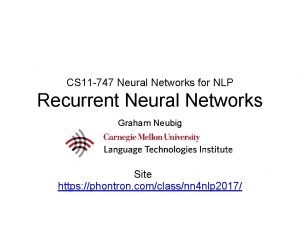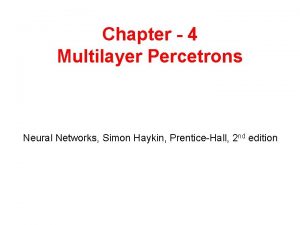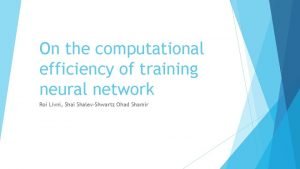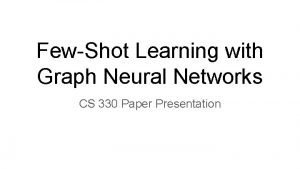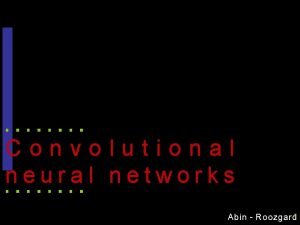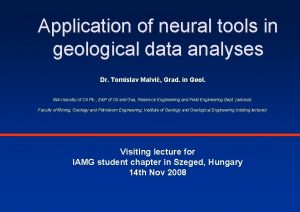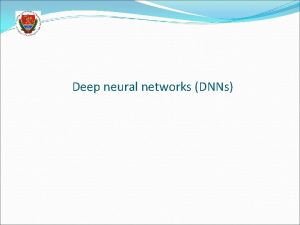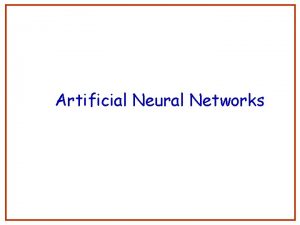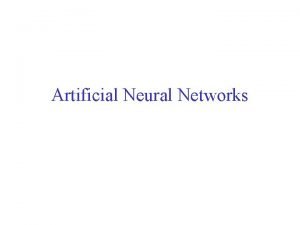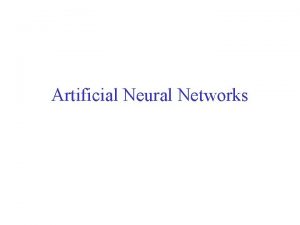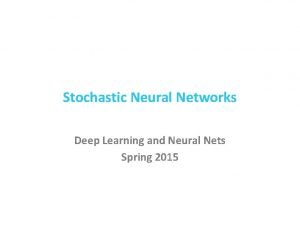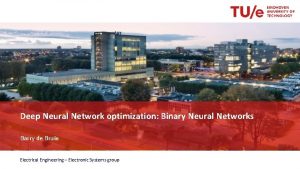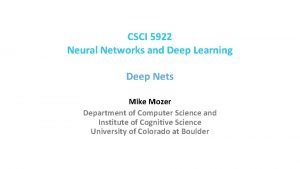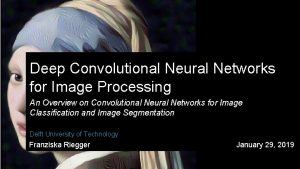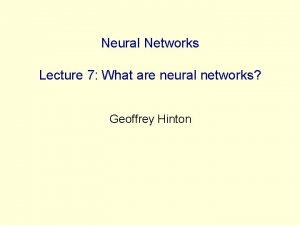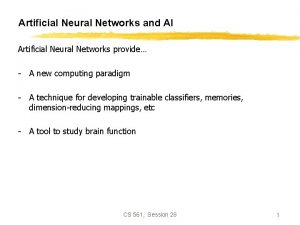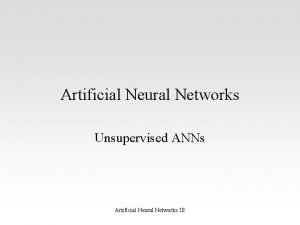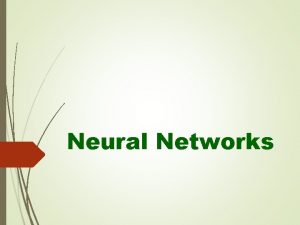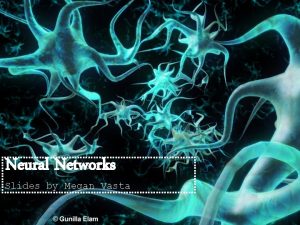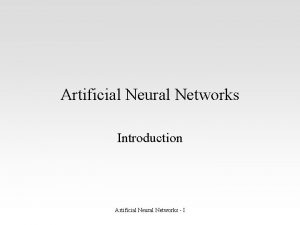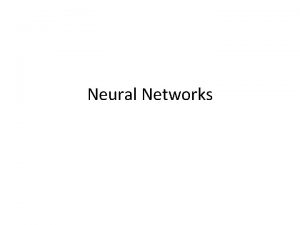Efficient Processing of Deep Neural Networks A Tutorial





























- Slides: 29

Efficient Processing of Deep Neural Networks: A Tutorial and survey Vivian Sze et. al. MIT

The whole paper ~ our course overview • Background on DNN • development history, training vs. inference, applications (Android project), embedded vs. cloud • Overview of DNN • convolutional neural network operations, popular models • DNN development resources • frameworks, pre-trained models, datasets (Android project) • Hardware for DNN processing • Near data processing • Trained network optimizations (sometimes with retraining) • quantization, pruning, compression, filter decomposition …… • Training smaller networks • squeezenet, mobilenet, ……. . • Benchmarking metrics for DNN evaluation and comparison

Parallel Compute Paradigms: Temporal vs. Spatial Architectures Centralized control for large number of ALUs only fetch data from memory hierarchy, no direct communication Use dataflow processing, ALU (called PE) with own control logic and local memory, can pass data from one to another directly

Efficient DNN with temporal architectures • CPU, GPU are general purpose processing elements, not specifically built for DNN • Still lot of efforts to improve efficiency (mostly runtime) • DNN operations expressed as matrix multiplications • less number of matrix multiplications using FFT, Strassen, Winograd and other approaches • hardware optimized linear algebra libraries – BLAS, cu. BLAS to do matrix multiplications faster • hardware optimization with instruction prefetching, optimal cache usage, vector instructions, pipelining

DNN operations as matrix multiplications FC layer Wx. H filter, C channels, M filters, 1 input map FC layer Wx. H filter, C channels, M filters, N input maps

DNN operations as matrix multiplications Convolution 3 x 3 filter, stride 3, 2 channels Equivalent matrix multiplication

DNN operations as matrix multiplications Convolution 2 x 2 filter, stride 1, 1 channel Toeplitz matrix or diagonal constant matrix, descending diagonal from left to right is constant

DNN operations as matrix multiplications Convolution 2 x 2 filter, two filters, stride 1, 1 channel • Positives • Use optimized matrix multiplication libraries available for CPU/GPU architectures • Negatives • Redundant data -> inefficiency in storage or complex memory access pattern

Less number of matrix multiplications

Less number of matrix multiplications

Less number of matrix multiplications

Less number of matrix multiplications

Less number of matrix multiplications

Less number of matrix multiplications

Hardware optimized (for latency) matrix multiplications • Instruction prefetching, pipelining • Parallelization – SIMD – SIMT • Exploit memory hierarchy with caches – http: //web. cs. ucdavis. edu/~bai/ECS 231/optmatmul. pdf – https: //people. eecs. berkeley. edu/~demmel/cs 267_Spr 99/ Lectures/Lect_02_1999 b. pdf

Parallel Compute Paradigms: Temporal vs. Spatial Architectures Centralized control for large number of ALUs only fetch data from memory hierarchy, no direct communication Use dataflow processing, ALU (called PE) with own control logic and local memory, can pass data from one to another directly

Efficient DNN with spatial architectures • Specialized architectures for DNN – Doesn’t piggyback on hardware optimized libraries after mapping DNN operations to generic algebraic operations like matrix multiplications – DNN operations scheduled on spatial architectures to exploit • parallelism among independent operations • sparsification of weight matrices (with pruning) and sparsification of activations (with RELU) for less computations • memory hierarchy across PE registers, PE interconnects, global buffer and DRAM for energy efficient dataflows • ………… – EIE (ISCA’ 16), SCNN (ISCA’ 17), Eyeriss (ISCA’ 16) are examples

Parallelism among independent operations EIE: For FC layers, each PE gets a portion of the activation and weights

Parallelism among independent operations Inter PE parallelism each PE gets Wt*Ht portion of activations Intra PE parallelism each multiplier in a PE gets I activations and F weights Output coordinate SCNN: For Conv layers, each PE and each PE multiplier get a portion of the activation and weights

Sparsity and compression v x p EIE and SCNN: non-zero weights stored with additional indeces

Memory hierarchy • N = 1 for inference • Reuse activations: Input Stationary IS • Reuse filters SCNN: Planar Tiled-Input Stationary-Cartesian Product-Sparse dataflow

Memory hierarchy Eyeriss related work: weight and output stationary, no local reuse

Memory hierarchy Eyeriss: row stationary in 1 D and 2 D convolutions

Core ideas’ similarities between temporal and spatial architectures – DNN operations expressed as matrix multiplications – less number of matrix multiplications using FFT, Strassen, Winograd and other approaches (reduced operations with sparsity in spatial) – hardware optimized linear algebra libraries – BLAS, cu. BLAS to do matrix multiplications faster – hardware optimization with instruction prefetching, optimal cache usage (memory hierarchy in spatial), vector instructions, pipelining (parallelization among independent operations in spatial)

Software design for temporal architectures Higher layers are hardware architecture agnostic – provided by ML researchers Lower layers are hardware architecture aware – provided by platform vendors

How to use a new accelerator http: //nvdla. org/ List of DNN chips https: //medium. com/@shan. tang. g/a-list-of-chip-ip-for-deep-learning-48 d 05 f 1759 ae

The whole paper ~ our course overview • Background on DNN • development history, training vs. inference, applications (Android project), embedded vs. cloud • Overview of DNN • convolutional neural network operations, popular models • DNN development resources • frameworks, pre-trained models, datasets (Android project) • Hardware for DNN processing • Near data processing • Trained network optimizations (sometimes with retraining) • quantization, pruning, compression, filter decomposition …… • Training smaller networks • squeezenet, mobilenet, ……. . • Benchmarking metrics for DNN evaluation and comparison

Typical available embedded platform

Friday class For a given hardware platform (unlike past classes on computer architecture) and a given DNN (unlike post midsem-break classes), what optimizations can be done to improve latency and energy?
 Efficient processing of deep neural networks
Efficient processing of deep neural networks Deep forest: towards an alternative to deep neural networks
Deep forest: towards an alternative to deep neural networks Mippers
Mippers Productively efficient vs allocatively efficient
Productively efficient vs allocatively efficient Allocative efficiency
Allocative efficiency C b a d
C b a d Allocative efficiency vs productive efficiency
Allocative efficiency vs productive efficiency Allocative efficiency vs productive efficiency
Allocative efficiency vs productive efficiency Visualizing and understanding convolutional networks
Visualizing and understanding convolutional networks Fat shattering dimension
Fat shattering dimension Neural networks ib psychology
Neural networks ib psychology Audio super resolution using neural networks
Audio super resolution using neural networks Convolutional neural networks for visual recognition
Convolutional neural networks for visual recognition Leon gatys
Leon gatys Convolutional neural network presentation
Convolutional neural network presentation Neural networks and learning machines 3rd edition
Neural networks and learning machines 3rd edition Lstm components
Lstm components Newff matlab
Newff matlab Neural networks for rf and microwave design
Neural networks for rf and microwave design 11-747 neural networks for nlp
11-747 neural networks for nlp Perceptron xor
Perceptron xor Csrmm
Csrmm On the computational efficiency of training neural networks
On the computational efficiency of training neural networks Input layer
Input layer Neural networks and fuzzy logic
Neural networks and fuzzy logic Netinsights
Netinsights Convolutional neural networks
Convolutional neural networks Few shot learning with graph neural networks
Few shot learning with graph neural networks Convolutional neural networks
Convolutional neural networks Neuraltools neural networks
Neuraltools neural networks



















